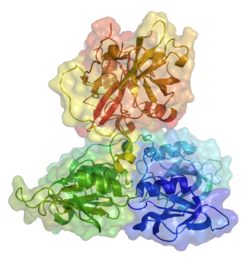Plasma Thromboplastin Antecedent
| Plasma Thromboplastin Antecedent | ||
|---|---|---|

|
||
| Belt / surface model according to PDB 2F83 | ||
| Properties of human protein | ||
| Mass / length primary structure | 607 amino acids | |
| Secondary to quaternary structure | Homodimer | |
| Isoforms | 2 | |
| Identifier | ||
| Gene names | F11 ; FXI; MGC141891 | |
| External IDs | ||
| Enzyme classification | ||
| EC, category | 3.4.21.27 , serine protease | |
| MEROPS | S01.213 | |
| Response type | Proteolysis | |
| Substrate | Arg - + - Ala or Arg - + - Val in factor IX | |
| Products | Factor IXa | |
| Occurrence | ||
| Homology family | Kallikrein | |
| Parent taxon | Terrestrial vertebrates | |
| Orthologue | ||
| human | House mouse | |
| Entrez | 2160 | 109821 |
| Ensemble | ENSG00000088926 | ENSMUSG00000031645 |
| UniProt | P03951 | Q91Y47 |
| Refseq (mRNA) | NM_000128 | NM_028066 |
| Refseq (protein) | NP_000119 | NP_082342 |
| Gene locus | Chr 4: 186.27 - 186.29 Mb | Chr 8: 45.24 - 45.26 Mb |
| PubMed search | 2160 |
109821
|
Plasma Thromboplastin Antecedent ( factor XI or PTA for short, English for the predecessor of plasma thromboplastin ), also Rosenthal factor, is an enzyme involved in blood clotting , more precisely a serine proteinase . It is produced by the liver and circulates as a homo-dimer ( covalently linked to one another via a disulfide bridge ) in its inactive form. The monomer has a molecular weight of 80 kDa . The concentration in plasma is 5 mg / l, its half-life is about 52 hours.
genetics
In humans, the gene for factor XI is on chromosome 4 , gene locus q32-35. It is 23 kbp in length and consists of 15 exons .
physiology
PTA is activated by activated Hageman factor (factor XIIa) or by thrombin and is then referred to as factor XIa. It belongs to the intrinsic pathway of blood clotting, which comes into action when Hageman factor and other components encounter negatively charged collagen under the endothelium of the vessel wall .
Factor XIa activates the Christmas factor (factor IX) by cleavage of an Arg - Ala - and Arg - Val - peptide binding to Factor IXa. The (activated) Christmas factor then activates the Stuart-Prower factor (factor X).
Diseases
Lack of PTA causes the rare hemophilia C . This occurs more frequently (8%) among Ashkenazi Jews , while in other populations it only affects about 1% of the population. In this type of haemophilia, spontaneous bleeding is rare, but surgery can cause severe blood loss and requires special preparation.
Low PTA levels can also occur in other diseases, such as Noonan's syndrome .
Elevated PTA levels are believed to play a role in causing thrombosis , but it is uncertain which factors cause the elevated levels and how severe the coagulant effects are.
Web links
- Plasma Thromboplastin Antecedent. In: Online Mendelian Inheritance in Man . (English)
Individual evidence
- ↑ R. Asakai, DW Chung, EW Davie, U. Seligsohn: Factor XI deficiency in Ashkenazi Jews in Israel. In: The New England Journal of Medicine . Volume 325, Number 3, July 1991, pp. 153-158, doi : 10.1056 / NEJM199107183250303 , PMID 2052060 .
- ↑ RM Bertina: Elevated clotting factor levels and venous thrombosis. In: Pathophysiology of haemostasis and thrombosis. Volume 33, Number 5-6, 2003 Sep-2004 Dec, pp 395-400, doi : 10.1159 / 000083835 , PMID 15692250 (review).
- ^ A. Siegemund, S. Petros, T. Siegemund, U. Scholz, HJ Seyfarth, L. Engelmann: The endogenous thrombin potential and high levels of coagulation factor VIII, factor IX and factor XI. In: Blood coagulation & fibrinolysis: an international journal in haemostasis and thrombosis. Volume 15, Number 3, April 2004, pp. 241-244, PMID 15060420 .